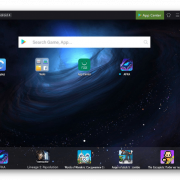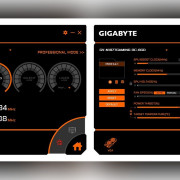Overclocked generator
Содержание:
- Есть ли в Overcooked! 2 кроссплей?
- OC Strategy #2: Package Temperature Threshold
- Other ways to play with friends
- Intel Rocket Lake Overview
- OC Strategy #1: Unlocked the Power Limits & XMP
- OC Strategy #3: AI Overclocking
- Free Updates[]
- Overclocking to 2.2 GHz
- Is Overcooked 2 Crossplay?
- Overcooked! 2[]
- Overcooked! 2: Surf ‘n’ Turf DLC[]
- Features[]
- Intel Core i5-11600K: Stock Performance
- Performance (Phoronix Benchmarks)
- Intel Rocket Lake Architecture.
Есть ли в Overcooked! 2 кроссплей?
Базовая игра Overcooked! 2 имеет очень ограниченный кроссплей. Те, кто играет в Steam и Epic Games Store, могут играть вместе на ПК до четырех игроков. Пользователи консолей PS4, Xbox и Switch не могут играть с друзьями в Overcooked! 2 в кроссплатформенном режиме.
До недавнего времени игра для всей семьи не поддерживала кроссплей ни на одной платформе, но она получила обновление, когда ее бесплатно раздавали в Epic Games Store. Однако бесплатная раздача и поддержка кроссплея создали множество проблем для PC-версии, и потребовался откат, чтобы сделать PC-версию снова пригодной для игры с друзьями.
Это уже не первый случай ошибки многопользовательской игры в Overcooked!, но Crossplay по-прежнему доступен для тех, кто хочет включить его в Steam и Epic Games Store, если у них нет проблем с этой функцией.
Игроки Overcooked! 2 на Game Pass PC не могут играть со своими друзьями на PC. Overcooked! All You Can Eat не входит в услугу подписки, а оригинальная игра не имеет кроссплатформенной поддержки в магазине Microsoft.
Другие способы игры с друзьями
Хотя владельцы консолей PlayStation, Xbox и Nintendo не могут играть с друзьями на других консолях, они могут играть по сети в кооперативном режиме со всеми, кто владеет игрой Overcooked! на той же консоли, что и они.
Кроме того, в Overcooked! 2 можно играть локально с четырьмя людьми, если у них достаточно контроллеров. В игре также есть функция, позволяющая двум людям управлять двумя разными персонажами с помощью одного контроллера. У пользователей Switch уже есть два контроллера с джойконами, поэтому эта функция, к сожалению, не предусмотрена в Pro Controller или Switch Lite.
Игроки могут даже объединить сетевой и локальный кооператив, чтобы играть с теми, кто живет с ними в одном доме, и с друзьями в других местах.
Будет ли добавлена поддержка совместной игры?
Ghost Town Games показали, что добавление кроссплатформенной игры не исключено, с новой поддержкой кроссплатформенной игры между Steam и Epic Games Store. Однако, похоже, что это было сделано для поддержки игры, пока она была бесплатной на витрине Epic.
С выходом Overcooked! All You Can Eat с ее функциями кроссплатформенной игры, кажется маловероятным, что студия вернется к добавлению кроссплатформенной поддержки в консольную версию. Однако также маловероятно, что студия добавит поддержку между игроками на ПК, поэтому все еще возможно, что кулинарный симулятор может получить кроссплейное обновление. Однако нет никаких признаков того, что это произойдет в ближайшее время.
Overcooked! 2 — это игра, которой лучше всего наслаждаться с друзьями, поэтому тем, кто хочет воспользоваться преимуществами совместной игры, скорее всего, придется перейти на более доступное издание All You Can Eat, чтобы играть с друзьями и семьей на других платформах.
OC Strategy #2: Package Temperature Threshold
Our second overclocking strategy utilizes the Package Temperature Threshold feature.
The package temperature threshold is one of the AI features included with most ASUS motherboards. This feature allows the user to target a specific maximum package temperature and will automatically increase the performance until it reaches this temperature. If the CPU package temperature goes over this threshold it will automatically reduce the frequency. This is a dynamic process that will continue to update the CPU frequency throughout your usage. We also used this feature during our i9-10900K overclocking test with Cryo cooling.
As ASUS has unlocked the turbo boost power limits by default on the Z590 motherboard, there may be an increased concern for overheating. By default, ASUS has also enabled the package temperature threshold and set it to 90C.
With custom loop water cooling we obviously should have more headroom than any other type of ambient cooling. Hence, we can increase the CPU frequency to 5000 MHz for all cores. That’s 100 MHz higher than the maximum single core boost frequency of 4.9 GHz, and 400 MHz higher than the maximum all core boost frequency of 4.6 GHz.
Upon entering the BIOS
- Go to the Extreme Tweaker menu
- Set AI Overclock Tuner to XMP I
- Set ASUS MultiCore Enhancement to Enabled – Remove All Limits
- Set CPU Core Ratio to Sync All Cores
- Set ALL-Core Ratio Limit to 50
- Enter the AI Features sub-menu
- Leave the AI Features sub-menu
- Enable Ring Down Bin
- Go to the Advanced menu
- Enter the CPU Configuration sub-menu
- Enter the CPU – Power Management Control sub-menu
Then save and exit the BIOS.
We re-ran the benchmarks and checked the performance increase compared to stock operation.

As expected, the performance rises in both lightly and heavily threaded workloads.

When running Prime 95 Small FFT with AVX enabled, the Core i5-11600K operates stably at an average of 4723 MHz with 1.366 volt. The average CPU temperature is 89 degrees centigrade, the average VRM temperature is 44 degrees centigrade, and the average water temperature is 26 degrees centigrade. The average CPU package power is 243 watt.

When running Prime 95 Small FFT with AVX disabled, the Core i5-11600K operates stably at 5 GHz with 1.442 volt. The average CPU temperature is 79 degrees centigrade, the average VRM temperature is 45 degrees centigrade, and the average water temperature is 26 degrees centigrade. The average CPU package power is 248 watt.
Other ways to play with friends
Although PlayStation, Xbox, and Nintendo console owners cannot play with friends on other consoles, they are able to play online co-op with anybody who owns Overcooked on the same console as them.
Alternatively, Overcooked 2 can be enjoyed locally with up to four people, as long as there are enough controllers to go around. The game also includes a feature that lets two people control two different characters with the one controller. Switch users already have two controllers with the joycons, so this feature is unfortunately not included with the Pro Controller or Switch Lite.
Players can even combine online and local co-op to play with those in the same household as them, and with friends elsewhere.
Intel Rocket Lake Overview
Intel’s 11th generation Core products for desktop, codenamed Rocket Lake, were officially introduced by Intel during the CES 2021 tradeshow in January and arrived to the market in March 2021.
Rocket Lake is the successor to Intel’s 10th generation Comet Lake processors. Rocket Lake sports a brand new CPU core architecture while still on the vastly improved 14nm process node. The CPU core is built upon the Cypress Cove architecture which is the backported version of Sunny Cove, a core designed for 10nm Ice Lake, with some additional performance improvements.
Due to the increased core size, the flagship Core i9-11900K offers up to 8 cores and 16 threads compared to its Core i9-10900K predecessor’s 10 cores and 20 threads. The Core i5 offer is still 6 cores and 12 threads. Rocket Lake CPUs do gain support for deep learning boost and AVX-512 instructions, a new and improved cache hierarchy, and up to 19% instructions per clock improvement.
Other new features include slightly elevated default memory support up to DDR4-3200, 20 PCIe 4.0 lanes from the CPU, doubled bandwidth of the DMI link, and moving the integrated graphics to the new Xe graphics architecture.
The Turbo Boost frequencies of the flagship processor are identical to the 10900K. So, we’ll see a base frequency of 3.5GHz, an all-core turbo of 4.8GHz, and a maximum thermal velocity boost frequency of 5.3GHz.
Compared to the 10600K, the 11600K has a 200MHz lower base frequency of 3.9GHz while offering a 100MHz higher maximum boost frequency of 4.9 GHz. For the i5-11600K processor, the long-term TDP is still 125W while the CPU can boost to 180W temporarily if sufficient turbo budget is available.
Rocket Lake will work on both 500 series and 400 series motherboards, though not on B460 or H410. Obviously that means Rocket Lake fits in the LGA1200 socket.
OC Strategy #1: Unlocked the Power Limits & XMP
Any aspiring overclocker should be aware of the Intel Turbo Boost 2.0 technology. Turbo Boost 2.0 enables higher CPU performance in situations where there is sufficient current, power, and temperature headroom.
The long story short is that Turbo Boost 2.0 allows the processor to operate at increased power consumption temporarily above the TDP rating to achieve higher performance. It manages this by accumulating “energy budget” during periods of idle time that can be deployed when necessary during periods of high load.
We discussed the Intel Turbo Boost 2.0 Technology at length in a previous video titled “Intel Turbo Boost 2.0 & Intel Turbo Boost Max 3.0 Explored”. While we use a different CPU, the Turbo Boost principles explained in that video also apply to our configuration.
By unlocking all the power limits, we effectively tell the CPU to run at the highest possible turbo boost settings all the time.
As we mentioned before, on the Maximus XIII Hero the power limits are unlocked by default. So all we need to do is load the optimized defaults and the power limits are unlocked.
We also enable XMP.
XMP stands for Extreme Memory Profile. It allows memory vendors such as Gskill to program higher performance settings onto the memory sticks. If the motherboard supports XMP, then you can enable the higher performance with a single BIOS setting. So it saves you from lots of manual configuration.
We discussed the Intel XMP Technology at length in a previous video titled “Intel Extreme Memory Profile Explained”. Check it out if you want additional information.
Upon entering the BIOS
- Go to the Extreme Tweaker menu
- Set AI Overclock Tuner to XMP I
- Set ASUS MultiCore Enhancement to Enabled – Remove All Limits
Then save and exit the BIOS.
We re-ran the benchmarks and checked the performance increase compared to default operation.

As expected, the performance uplift is most notable in multi-threaded benchmark applications which would typically be heavily constraint by the default power limits.

When running Prime 95 Small FFT with AVX enabled, the Core i5-11600K operates stably at 4.6 GHz with 1.301 volt. The average CPU temperature is 79 degrees centigrade, the average VRM temperature is 40 degrees centigrade, and the average water temperature is 25 degrees centigrade. The average CPU package power is 216 watt.
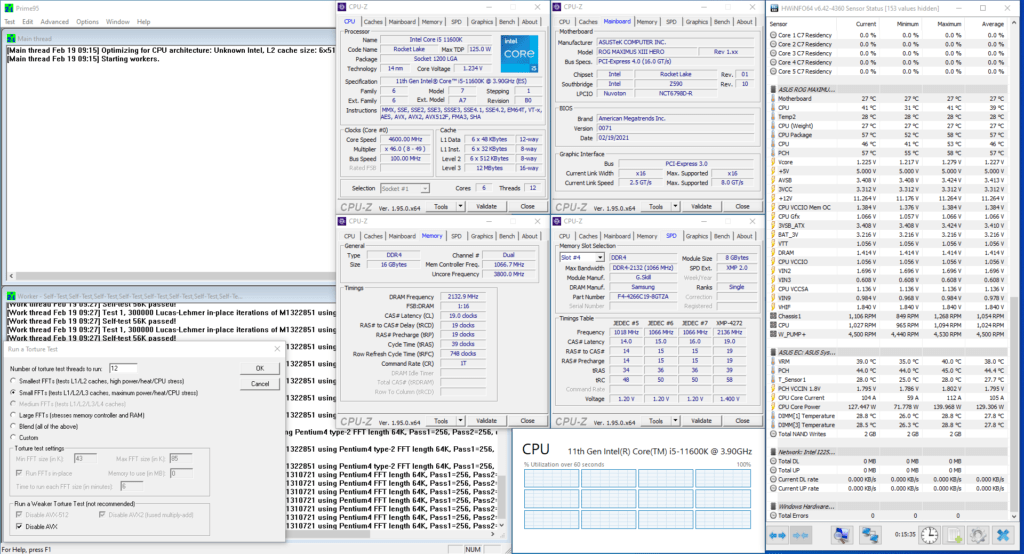
When running Prime 95 Small FFT with AVX disabled, the Core i5-11600K operates stably at 4.6 GHz with 1.227 volt. The average CPU temperature is 57 degrees centigrade, the average VRM temperature is 35 degrees centigrade, and the average water temperature is 28 degrees centigrade. The average CPU package power is 150 watt.
Anyway, let’s do manual overclocking.
Before you get started, make sure to identify the clear CMOS button on the IO panel. In case your system doesn’t boot up after trying overclocked settings, you can press this button to start from scratch.
OC Strategy #3: AI Overclocking
Our third overclocking strategy utilizes the ASUS AI Overclocking feature.
ASUS AI Overclocking is a novel approach to automatic overclocking. Rather than the engineers programming a couple of fixed overclock settings as options in the BIOS, AI overclocking attempts to work out the best overclock settings on its own. It does this by evaluating the quality of your processor and your cooling solution. Based on this evaluation, the proprietary algorithm will adjust the CPU frequency and voltages.
The process of enabling AI overclocking is very simple. First, boot up the system with default settings into the operating system. Then, run a couple of heavy workload benchmarks like Cinebench, Realbench, or Prime95. After about 30 minutes the system will have collected sufficient data on your cooler and CPU. Then, return to the BIOS and simply enable AI overclocking. That’s it!
In our case, AI overclocking set the single core OC to 5 GHz and the all-core OC to 4.7 GHz. So, a 100 MHz bump from default maximum boost frequencies.
Upon entering the BIOS
- Go to the Extreme Tweaker menu
- Set AI Overclock Tuner to XMP I
- Set ASUS MultiCore Enhancement to Enabled – Remove All Limits
- Set CPU Core Ratio to AI Optimized
Then save and exit the BIOS.
We re-ran the benchmarks and checked the performance increase compared to stock operation.
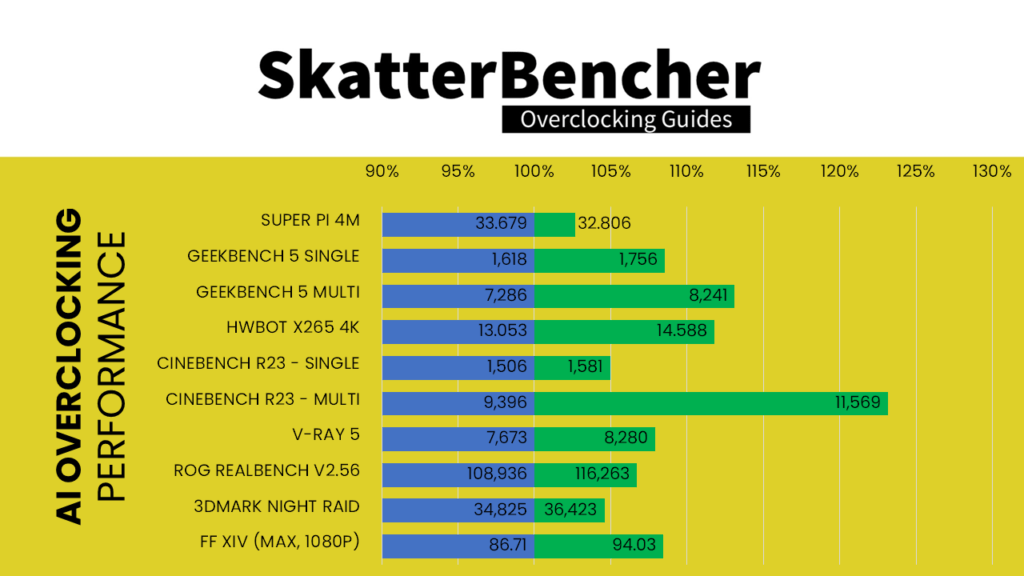
As you can see, the performance increases across the board. However, in all-core multi-threaded applications we find the performance to be lower than our second strategy with package temperature threshold due to the lower frequency.

When running Prime 95 Small FFT with AVX enabled, the Core i5-11600K operates stably at 4.7GHz with 1.351 volt. The average CPU temperature is 89 degrees centigrade, the average VRM temperature is 43 degrees centigrade, and the average water temperature is 25 degrees centigrade. The average CPU package power is 241 watt.
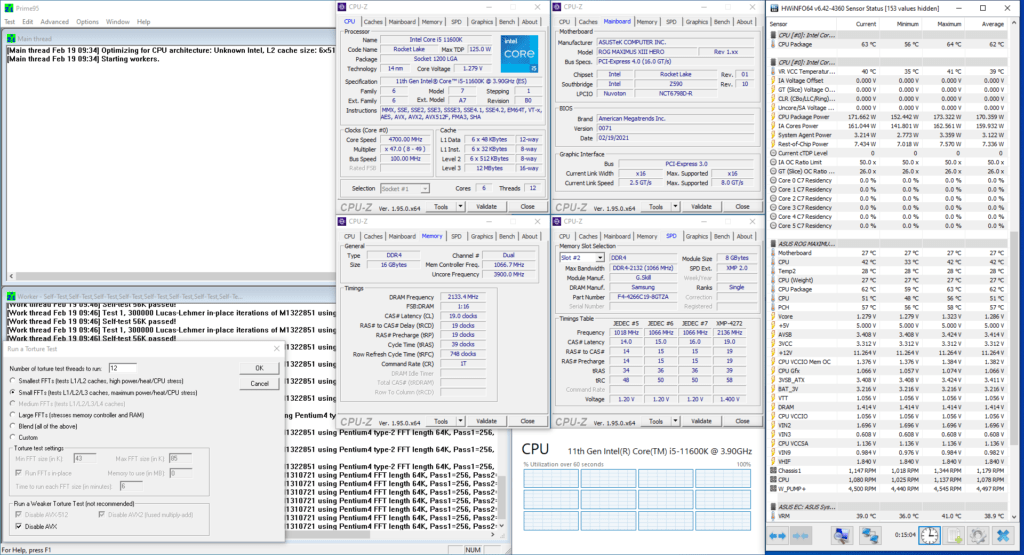
When running Prime 95 Small FFT with AVX disabled, the Core i5-11600K operates stably at 4.7 GHz with 1.286 volt. The average CPU temperature is 62 degrees centigrade, the average VRM temperature is 39 degrees centigrade, and the average water temperature is 27 degrees centigrade. The average CPU package power is 170 watt.
Free Updates[]
On August 24, 2018, the New Game + update went live on Steam and was released on consoles on October 3, 2018. It added a new 4-star difficulty option and made some changes to Story Mode and the World Map.
On December 14, 2018, the Kevin’s Christmas Cracker update went live on Steam. It added 5 more levels, 2 new recipes, and practice mode.
On February 5th, 2019, the Chinese New Year Update went live on Steam. It added 7 new levels, 2 new recipes, and survival mode.
On December 17th, 2019, the Winter Wonderland update went live on all platforms. It added 5 seasonal levels from the 2019 DLC (one from Campfire Cook Off, two from Night of the Hangry Horde and two from Carnival of Chaos), 2 new chefs, Horde Mode, and 5 seasonal recipes.
On January 23rd, 2020, the Spring Festival update went live on all platforms except Xbox. It added 5 new levels, along with two new chefs (the rat and turtle).
On July 5th, 2020, the Sun’s Out Bun’s Out went live on Steam. It was released on consoles on July 16th, 2020. It added 5 new levels, 2 new recipes, and two new chefs.
On October 1st 2020, the Moon Harvest update went live on Steam. It added 5 new levels, 1 new recipe (with 3 variations) and a new kitchen hazard.
Overclocking to 2.2 GHz
So… the Pi 400 is the first Pi I’m able to reliably run at more than 2.147 GHz. After reading this Tom’s Hardware review of the Pi 400, I noted that Les Pounder was able to get the chip to run at 2.2 GHz.
My first attempt to overclock to 2.147 GHz, by setting the following in , resulted in a Pi that would only boot halfway then get locked up:
If could set successfully, but I figured I should go big or go home. I figured it was a power issue, and to set higher than 6, I had to set .
And now it booted up and ran at 2.2 GHz, just like in the Tom’s Hardware review!
I ran the same test for a full 30 minutes, and here’s the temperature graph:
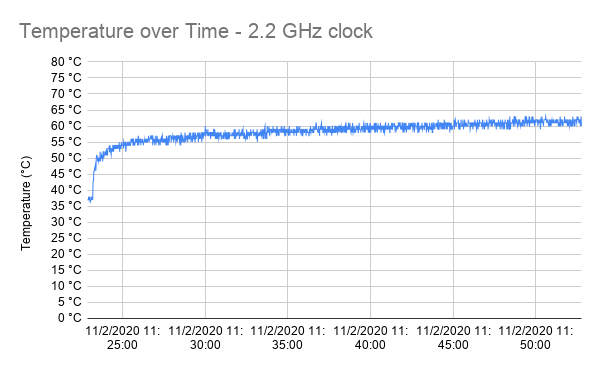
It reached a peak of 63°C, which is still well under the throttling temperature. For comparison, check out the same graph from my overclocked benchmarks on the Compute Module 4, with a massive fan (but no heat sink):
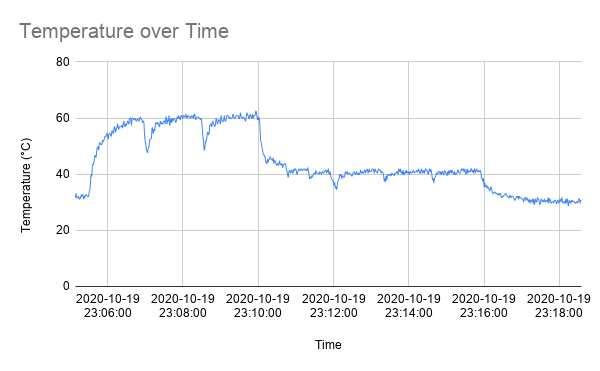
And without a fan, the CM4 behaves like a Pi 4 model B, and reaches 75°C and beyond, throttling the CPU after a while. It’s great to see the passively-cooled Pi 400 can keep from throttling, even overclocked to 2.2 GHz!
Here’s a thermal image after 30 minutes of at 2.2 GHz:
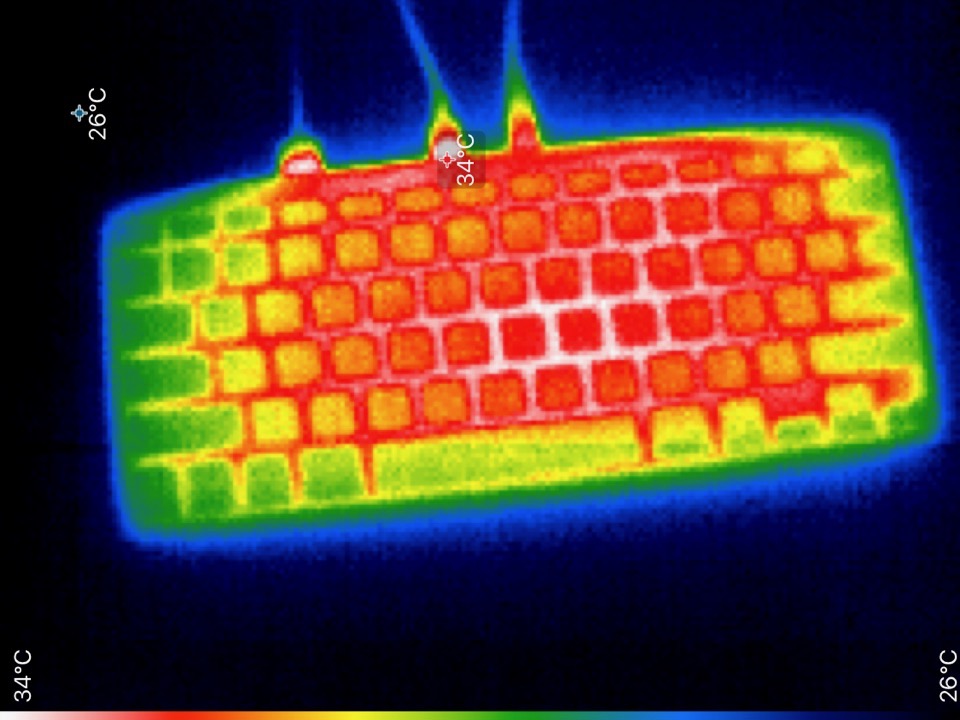
The top was very slightly warm, though still not an issue at all. The bottom was noticeably warm now, like the back of my phone when I use it to watch some streaming videos for a while, but not uncomfortably so. The ports on the back still showed the highest external temps overall, at 42°C:
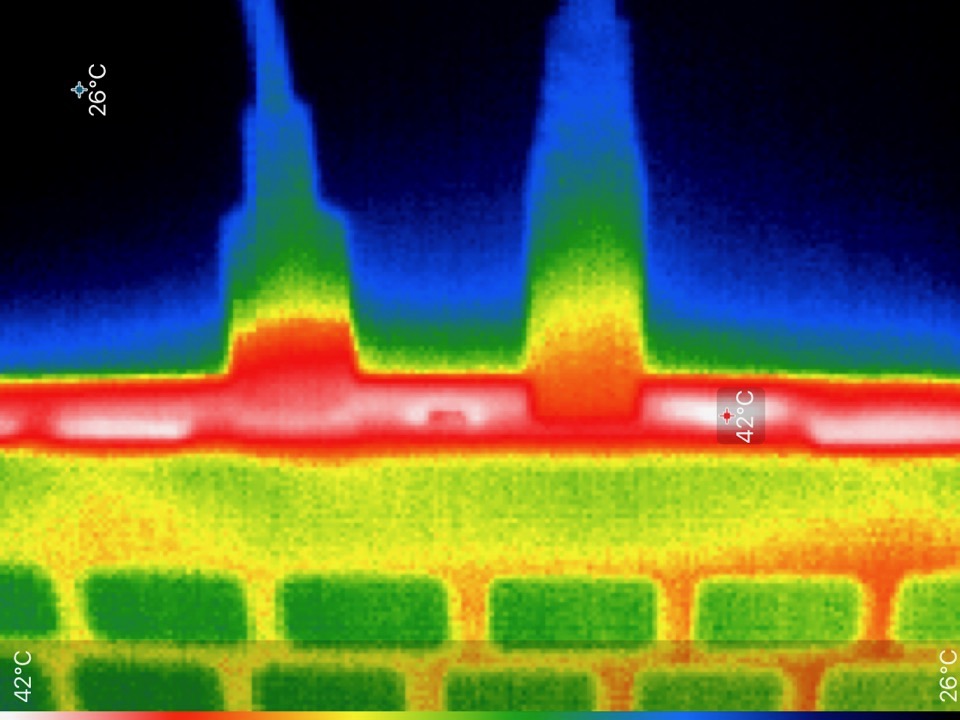
Another important difference from the Pi 4 model B: it seems like the microSD card itself doesn’t get quite as hot either (though I only measured by touch), maybe due to the fact that the SoC’s heat is transferred out more through the heat sink than the Pi’s board itself.
Is Overcooked 2 Crossplay?
The base game of Overcooked 2 has very limited crossplay. Those playing on Steam and the Epic Games Store are able to play together on PC with up to four players. Console users on PS4, Xbox, and Switch are not able to play Overcooked 2 cross-platform with friends.
Until recently the family-friendly title was not crossplay enabled on any platform, but it received an update when given out for free on the Epic Games Store. However, the free giveaway and crossplay support created many problems for the PC version, and a rollback was needed to make the PC versions playable with friends again.
This isn’t the first time there has been a multiplayer bug in Overcooked, but Crossplay is still available for those on Steam and the Epic Games Store who want to enable it, should they not have any issues with the feature.
Overcooked 2 players on Game Pass PC cannot play with their PC friends. The Overcooked! All You Can Eat version is not included with the subscription service, and the original game does not have cross-platform support on Microsoft’s Store.
Overcooked! 2[]
The tables below list all the levels in Overcooked! 2 by order of appearance.
The recipes that appear in the level are also listed, along with the need for washing dirty plates and the score required for 3 stars and 4 stars. Timed at start is true if the timer counts down right away, false if the timer starts when you submit your first dish.
| Level | Recipes | Wash Plates | Score (1P) | (2P) | (3P) | (4P) | ||||
|---|---|---|---|---|---|---|---|---|---|---|
| 3* | 4* | 3* | 4* | 3* | 4* | 3* | 4* | |||
| Tutorial | Salad | No | 60 | 400 | 60 | 600 | 60 | 800 | 60 | 900 |
World 1
| Level | Recipes | Wash Plates | Score (1P) | (2P) | (3P) | (4P) | Timed at start | ||||
|---|---|---|---|---|---|---|---|---|---|---|---|
| 3* | 4* | 3* | 4* | 3* | 4* | 3* | 4* | ||||
| 1-1 | Sashimi | No | 240 | 1000 | 300 | 2000 | 400 | 2500 | 400 | 2800 | False |
| 1-2 | Sushi | No | 300 | 1000 | 420 | 1800 | 460 | 2 | 460 | 2500 | False |
| 1-3 | Sushi | Yes | 160 | 890 | 320 | 1250 | 340 | 1600 | 340 | 1900 | True |
| 1-4 | Sushi | Yes | 340 | 950 | 400 | 1100 | 460 | 1500 | 460 | 1600 | True |
| 1-5 | Pasta | Yes | 200 | 700 | 260 | 900 | 360 | 1100 | 360 | 1200 | False |
| 1-6 | Salad
Sushi |
Yes | 340 | 1050 | 440 | 1500 | 520 | 2100 | 520 | 2000 | True |
World 2
| Level | Recipes | Wash Plates | Score (1P) | (2P) | (3P) | (4P) | Timed at start | ||||
|---|---|---|---|---|---|---|---|---|---|---|---|
| 3* | 4* | 3* | 4* | 3* | 4* | 3* | 4* | ||||
| 2-1 | Chicken | No | 220 | 520 | 320 | 820 | 340 | 1000 | 340 | 1500 | True |
| 2-2 | Pasta | No | 340 | 750 | 480 | 1050 | 620 | 1250 | 620 | 1250 | True |
| 2-3 | Pasta | Yes | 260 | 700 | 400 | 700 | 480 | 700 | 480 | 700 | True |
| 2-4 | Burritos | Yes | 560 | 1250 | 660 | 1700 | 940 | 2500 | 940 | 2600 | False |
| 2-5 | Burritos | Yes | 400 | 800 | 460 | 1000 | 600 | 1400 | 600 | 1400 | True |
| 2-6 | Burgers | Yes | 460 | 1180 | 740 | 1600 | 880 | 1900 | 880 | 2200 | False |
World 3
| Level | Recipes | Wash Plates | Score (1P) | (2P) | (3P) | (4P) | Timed at start | ||||
|---|---|---|---|---|---|---|---|---|---|---|---|
| 3* | 4* | 3* | 4* | 3* | 4* | 3* | 4* | ||||
| 3-1 | Pizza | Yes | 460 | 830 | 820 | 1500 | 1040 | 1650 | 1040 | 1900 | False |
| 3-2 | Burgers | No | 320 | 750 | 500 | 950 | 640 | 1250 | 640 | 1350 | True |
| 3-3 | Pizza | Yes | 380 | 660 | 640 | 1450 | 800 | 1650 | 800 | 1750 | True |
| 3-4 | Burgers | Yes | 300 | 600 | 440 | 950 | 540 | 1100 | 540 | 1400 | True |
| 3-5 | Chicken
Fries |
Yes | 240 | 830 | 420 | 850 | 440 | 950 | 440 | 950 | True |
| 3-6 | Burritos | No | 400 | 1050 | 560 | 1600 | 740 | 1800 | 740 | 2100 | True |
World 4
| Level | Recipes | Wash Plates | Score (1P) | (2P) | (3P) | (4P) | Timed at start | ||||
|---|---|---|---|---|---|---|---|---|---|---|---|
| 3* | 4* | 3* | 4* | 3* | 4* | 3* | 4* | ||||
| 4-1 | SushiSashimi | Yes | 240 | 620 | 460 | 1000 | 640 | 1100 | 640 | 1340 | True |
| 4-2 | SaladChickenFries | Yes | 400 | 790 | 420 | 1080 | 480 | 900 | 480 | 1150 | True |
| 4-3 | Burgers | Yes | 300 | 600 | 340 | 950 | 520 | 1100 | 520 | 1300 | True |
| 4-4 | ChickenFries | Yes | 380 | 800 | 520 | 980 | 520 | 1100 | 520 | 1180 | True |
| 4-5 | SashimiSushi | Yes | 360 | 650 | 480 | 950 | 560 | 950 | 560 | 950 | True |
| 4-6 | Burrito | Yes | 320 | 800 | 580 | 1050 | 860 | 1250 | 860 | 1450 | True |
World 5
| Level | Recipes | Wash Plates | Score (1P) | (2P) | (3P) | (4P) | Timed at start | ||||
|---|---|---|---|---|---|---|---|---|---|---|---|
| 3* | 4* | 3* | 4* | 3* | 4* | 3* | 4* | ||||
| 5-1 | Sushi
Burgers |
Yes | 420 | 700 | 480 | 1000 | 520 | 1250 | 520 | 1400 | True |
| 5-2 | Burgers | Yes | 300 | 580 | 420 | 1100 | 340 | 1250 | 340 | 1550 | True |
| 5-3 | Burritos | Yes | 200 | 680 | 480 | 1050 | 500 | 1050 | 500 | 1050 | True |
| 5-4 | Pancakes | Yes | 280 | 1150 | 460 | 1450 | 400 | 1450 | 400 | 1700 | False |
| 5-5 | Pasta | Yes | 280 | 650 | 480 | 1000 | 480 | 1050 | 480 | 1300 | True |
| 5-6 | Pasta | Yes | 480 | 950 | 520 | 1540 | 500 | 1600 | 500 | 1700 |
World 6
| Level | Recipes | Wash Plates | Score (1P) | (2P) | (3P) | (4P) | |||||
|---|---|---|---|---|---|---|---|---|---|---|---|
| 3* | 4* | 3* | 4* | 3* | 4* | 3* | 4* | ||||
| 6-1 | Cake | Yes | 620 | 820 | 700 | 1250 | 980 | 1600 | 980 | 1450 | |
| 6-2 | Pancakes
Cake |
Yes | 280 | 600 | 300 | 650 | 340 | 720 | 340 | 800 | |
| 6-3 | Pancakes
Cake |
No | 520 | 850 | 640 | 1200 | 920 | 1200 | 920 | 1450 | |
| 6-4 | Pizza
Burgers |
Yes | 260 | 600 | 440 | 900 | 580 | 950 | 580 | 1150 | |
| 6-5 | Burgers | Yes | 300 | 480 | 400 | 750 | 420 | 750 | 420 | 940 | |
| 6-6 | All | Yes | 1500 | 1900 | 1500 | 2100 | 1500 | 2100 | 1500 | 2100 |
Kevin Levels
For details on how to unlock these levels see Kevin Levels.
| Level | Recipes | Wash Plates | Score (1P) | (2P) | (3P) | (4P) | ||||
|---|---|---|---|---|---|---|---|---|---|---|
| 3* | 4* | 3* | 4* | 3* | 4* | 3* | 4* | |||
| Kevin 1 | Dumplings
Fish |
Yes | 520 | 920 | 820 | 1460 | 900 | 1650 | 900 | 1920 |
| Kevin 2 | Dumplings
Fish |
Yes | 420 | 950 | 640 | 1300 | 720 | 1400 | 720 | 1250 |
| Kevin 3 | Dumplings
Fish |
Yes | 340 | 690 | 400 | 800 | 640 | 900 | 640 | 1060 |
| Kevin 4 | Dumplings
Fish |
Yes | 380 | 800 | 580 | 960 | 680 | 1250 | 680 | 1600 |
| Kevin 5 | Dumplings
Fish |
Yes | 320 | 620 | 440 | 1000 | 560 | 1100 | 560 | 1100 |
| Kevin 6 | Dumplings
Fish |
Yes | 380 | 650 | 480 | 900 | 640 | 1000 | 640 | 1000 |
| Kevin 7 | Dumplings
Fish |
Yes | 420 | 800 | 500 | 1280 | 540 | 1280 | 540 | 1280 |
| Kevin 8 | Dumplings
Fish |
Yes | 300 | 700 | 320 | 800 | 420 | 1040 | 420 | 1000 |
Overcooked! 2: Surf ‘n’ Turf DLC[]
World 1
| Level | Recipes | Wash Plates | Score (1P) | (2P) | (3P) | (4P) | ||||
|---|---|---|---|---|---|---|---|---|---|---|
| 3* | 4* | 3* | 4* | 3* | 4* | 3* | 4* | |||
| 1-1 | Smoothies | Sink | 600 | 720 | 980 | 1200 | 840 | 1320 | 840 | 1320 |
| 1-2 | Smoothies | Sink | 460 | 540 | 1060 | 1300 | 900 | 1400 | 1000 | 1550 |
| 1-3 | Burgers | Water Gun | 420 | 500 | 1020 | 1200 | 780 | 1220 | 1000 | 1540 |
| 1-4 | Smoothies | Water Gun | 460 | 540 | 800 | 970 | 680 | 1050 | 700 | 1100 |
World 2
| Level | Recipes | Wash Plates | Score (1P) | (2P) | (3P) | (4P) | ||||
|---|---|---|---|---|---|---|---|---|---|---|
| 3* | 4* | 3* | 4* | 3* | 4* | 3* | 4* | |||
| 2-1 | Kebobs | Water Gun | 480 | 560 | 740 | 890 | ||||
| 2-2 | Kebobs | No | 320 | 390 | 600 | 720 | ||||
| 2-3 | Burgers | Sink | 420 | 500 | 540 | 650 | ||||
| 2-4 | Cake | Sink | 500 | 580 | 880 | 1080 |
World 3
| Level | Recipes | Wash Plates | Score (1P) | (2P) | (3P) | (4P) | ||||
|---|---|---|---|---|---|---|---|---|---|---|
| 3* | 4* | 3* | 4* | 3* | 4* | 3* | 4* | |||
| 3-1 | Kebobs | Sink | 460 | 540 | 780 | 930 | ||||
| 3-2 | Smoothies
Kebobs |
Water Gun | 420 | 490 | 620 | 750 | ||||
| 3-3 | Pancakes | No | 500 | 600 | 600 | 720 | ||||
| 3-4 | Smoothies
Kebobs |
Water Gun | 560 | 690 | 1080 | 1685 |
Features[]
- Online multiplayer! For the first time, you can cook up a storm with up to four players in both local and online multiplayer!
- Throwing! Throwing is now an official game mechanic, allowing you to toss ingredients to your fellow chefs or even straight into the pan/blender/onto the floor!
- New level mechanics! Overcooked 2 sees the introduction of new game mechanics including moving walkways, controllable platforms, and even portals!
- Dynamic levels! Throwing you from the frying pan and into the fire, dynamic levels will change around you, offering a new challenge to overcome as the recipes and levels themselves change!
- Interactive world map! As you drive, sail and soar your way around the map in the Onion King’s amphibious air bus you will open up new areas using hidden buttons around the world!
- Kitchens! From the neon lights of a sushi restaurant to the bubbling pots of a Wizard school kitchen, there are plenty of places to cook up a storm in Overcooked 2!
- Recipes! From spaghetti to sushi and pancakes to pizza, recipes both old and new will need to be cooked to perfection (or at least not burnt to a crisp!) New recipes mean new ingredients and new equipment so even the most well-seasoned Overcooked players will be challenged!
- Chefs! Overcooked 2 introduces a whole host of new of chefs to play in the kitchen including an eagle, mouse, beaver and what kitchen is complete without an octopus!
Intel Core i5-11600K: Stock Performance
Before we get started with pushing the performance of the Intel Core i5-11600K processor, let’s first take a look at the scoring at stock settings.
Note that by default the Maximus XIII Hero has Turbo Boost 2.0 limits unlocked, so in order to see the performance at stock settings you will have to go into the BIOS
- Go to the Extreme Tweaker menu
- Set ASUS MultiCore Enhancement to Disabled – Enforce All Limits
Here’s the performance at stock:


When running Prime 95 Small FFT with AVX enabled, the Core i5-11600K operates stably at 4 GHz with 1.124 volt. The average CPU temperature is 59 degrees centigrade, the average VRM temperature is 35 degrees centigrade, and the average water temperature is 25 degrees centigrade. The average CPU package power is 127 watt.

When running Prime 95 Small FFT with AVX disabled, the Core i5-11600K operates stably at 4.4 GHz with 1.175 volt. The average CPU temperature is 53 degrees centigrade, the average VRM temperature is 35 degrees centigrade, and the average water temperature is 26 degrees centigrade. The average CPU package power is 127 watt.
Now, let’s try our first overclocking strategy.
However, before we get started make sure to locate the CMOS clear button on your motherboard. In case your system failed to boot up after you configured your settings, pressing this button will reset the bios and you’ll be able to boot up safely.
Performance (Phoronix Benchmarks)
I also ran a set of Phoronix CPU benchmarks—specifically, this benchmark that I have been running on all the Pi 4 series computers—and here are the results at 2.2 GHz, compared to an actively-cooled Pi Compute Module 4 running at 1.5 and 2.0 GHz:
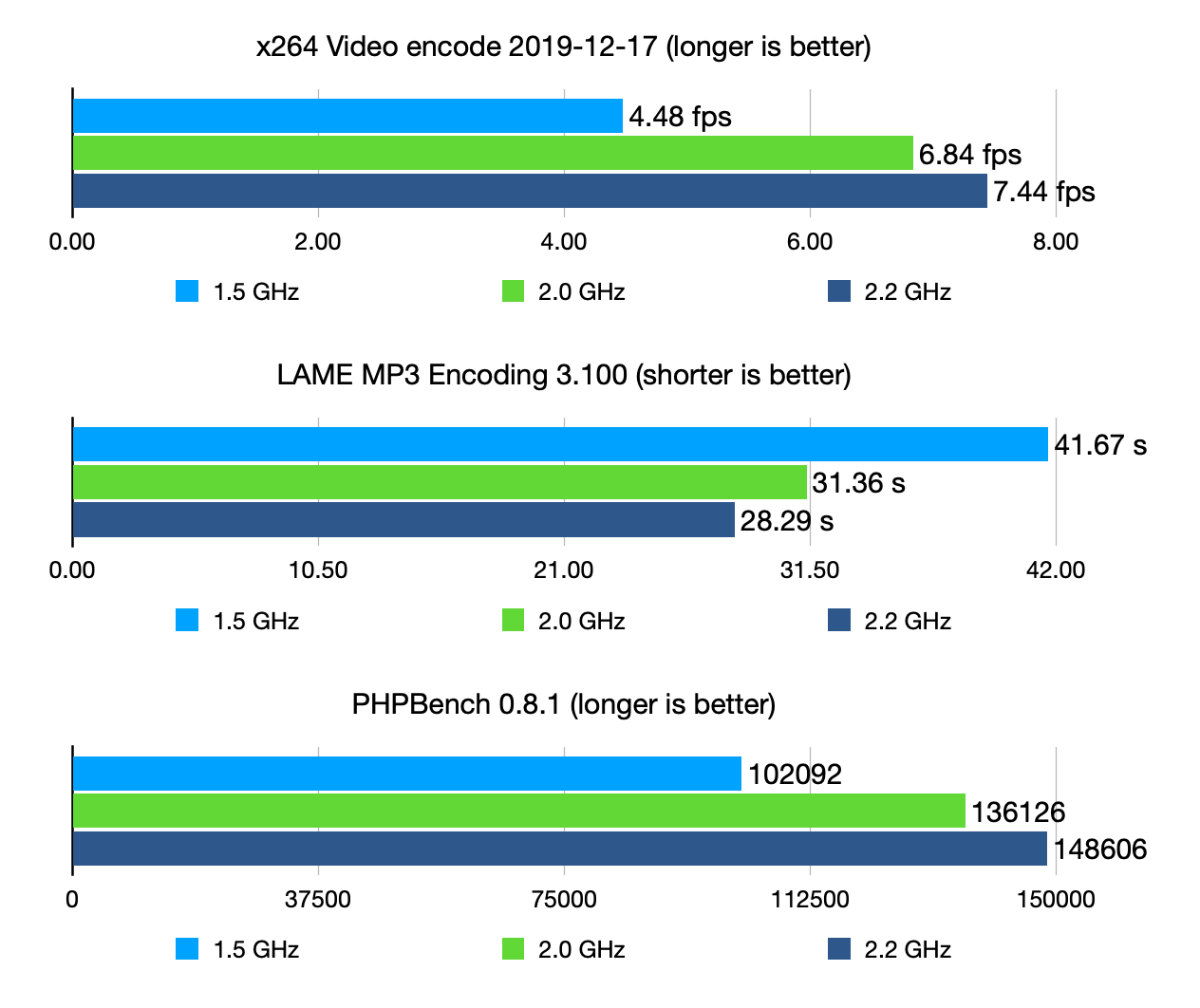
Performance scales pretty much linearly with respect to the clock speed, which is to be expected with the exact same CPU architecture.
I did some testing with YouTube, and found that playing back videos at 1080p was much more enjoyable at the 2.2 GHz clock, though doing things like switching between fullscreen playback and windowed playback was still a bit slow.
Intel Rocket Lake Architecture.
Intel’s 11th generation Core products for desktop, codenamed Rocket Lake, were officially introduced by Intel during the CES 2021 tradeshow in January and arrived to the market in March 2021.
Rocket Lake is the successor to Intel’s 10th generation Comet Lake processors. Rocket Lake sports a brand new CPU core architecture while still on the vastly improved 14nm process node. The CPU core is built upon the Cypress Cove architecture which is the backported version of Sunny Cove, a core designed for 10nm Ice Lake, with some additional performance improvements.
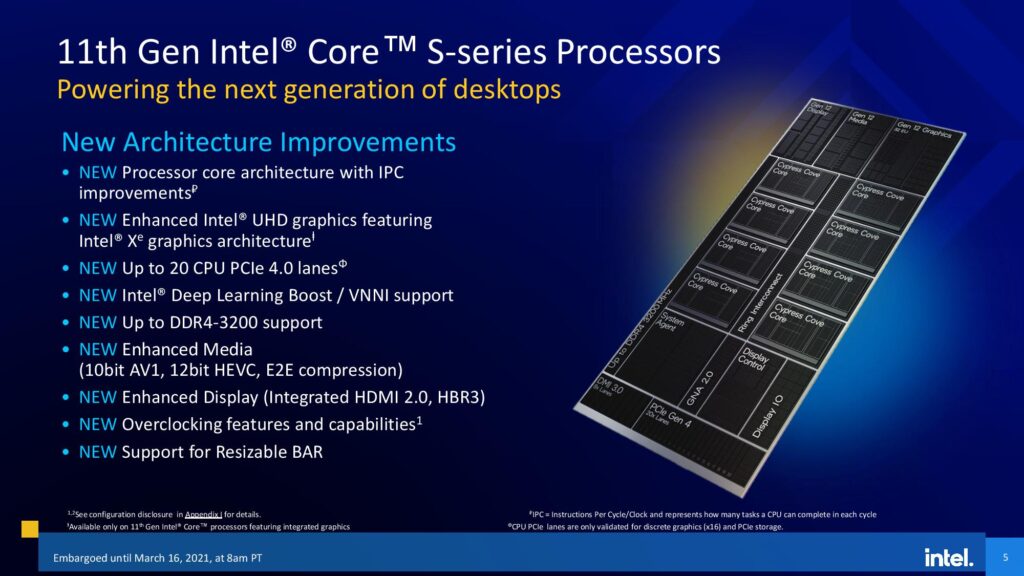
Due to the increased core size, the flagship Core i9-11900K offers up to 8 cores and 16 threads compared to its Core i9-10900K predecessor’s 10 cores and 20 threads. It does gain support for deep learning boost and AVX-512 instructions, a new and improved cache hierarchy, and up to 19% instructions per clock improvement.
Other new features include slightly elevated default memory support up to DDR4-3200, 20 PCIe 4.0 lanes from the CPU, doubled bandwidth of the DMI link, and moving the integrated graphics to the new Xe graphics architecture.
The overclockable K-SKU processors again come in three flavors: Core i9, Core i7, and Core i5. Each of the three flavors has a -K a -KF variant. The only difference between the two variants is that the -KF comes without integrated graphics.
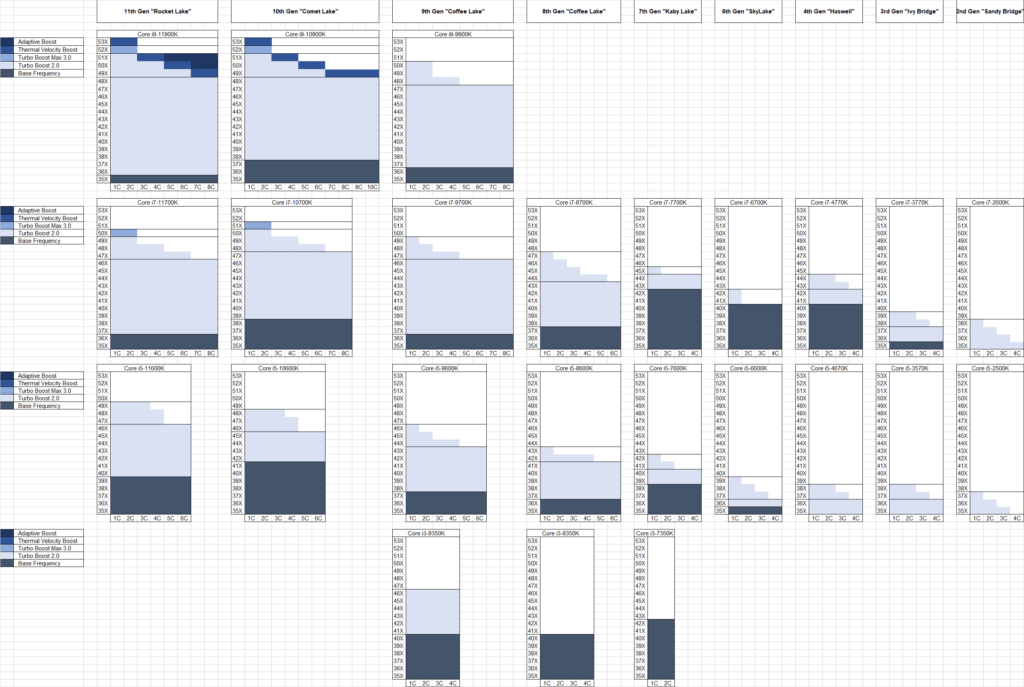
The frequencies of the flagship Core i9-11900K processor are nearly identical to the Core i9-10900K. So, we’ll see a base frequency of 3.5GHz, an all-core turbo of 4.8GHz, and a maximum thermal velocity boost frequency of 5.3GHz. The TDP is 125W and the CPU can boost up to 250W temporarily.
The frequencies of the Core i7-11700K processor are slightly lower than the Core i7-10700K. The base frequency is 3.6GHz, an all-core turbo of 4.6GHz, and a maximum turbo boost frequency of 5.0GHz. The TDP is 125W and the CPU can boost up to 250W temporarily.
The frequencies of the Core i5-11600K processor are also slightly lower than the Core i5-10600K. The base frequency is 3.9GHz, an all-core turbo of 4.6GHz, and a maximum turbo boost frequency of 4.9GHz. The TDP is 125W and the CPU can boost up to 180W temporarily.
Rocket Lake will work on both 500 series and 400 series motherboards, though not on B460 or H410. Obviously that means Rocket Lake fits in the LGA1200 socket.


